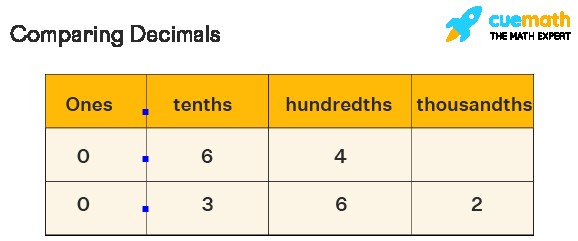Comparing decimals is a crucial skill for students as they progress in mathematics. It involves determining which decimal number is larger or smaller in a given set. This article outlines effective strategies for teaching students how to compare decimals accurately.
Understanding Place Value: The Foundation of Comparing Decimals
Before diving into comparison, ensure students have a solid grasp of place value. Reinforce that the digits after the decimal point represent fractions of a whole: tenths, hundredths, thousandths, and so on. Using a place value chart can visually represent the value of each digit in a decimal number.
Step-by-Step Comparison Strategies
Introduce a systematic approach to comparing decimals:
-
Whole Number Comparison: Begin by comparing the whole number parts of the decimals. If they differ, the decimal with the larger whole number is greater. For example, in comparing 12.5 and 8.9, 12 is greater than 8, therefore 12.5 is greater than 8.9.
-
Tenths Place Comparison: If the whole numbers are equal, move to the tenths place. The decimal with the larger digit in the tenths place is greater. If these are also equal, proceed to the hundredths place, and so on.
-
Using Zero Placeholders: When decimals have different numbers of digits after the decimal point, teach students to add zeros as placeholders. This makes the comparison clearer. For example, to compare 0.7 and 0.75, add a zero to 0.7 to make it 0.70. Then, compare 0.70 and 0.75. Since 5 is greater than 0, 0.75 is greater than 0.70.
Visual Aids for Enhanced Understanding
Visual aids can significantly improve comprehension:
- Number Lines: Plotting decimals on a number line provides a visual representation of their relative magnitude. Students can see which decimal falls further to the right, indicating the larger value.
- Place Value Charts: Align decimals vertically in a place value chart to emphasize the importance of comparing digits in the same place value column.
Real-World Applications and Engaging Activities
Connect comparing decimals to real-life scenarios:
-
Money: Use money examples to illustrate decimal comparisons. For instance, ask students to compare prices of items or determine which amount of money is greater.
-
Measurement: Incorporate measurement activities. Have students measure lengths or weights and then compare the decimal values obtained.
-
Games: Design games that involve comparing decimals. For example, a card game where students draw decimal cards and compare them to determine the winner.
Addressing Common Misconceptions
Be mindful of common misunderstandings:
-
Longer Decimals are Larger: Students might mistakenly believe that decimals with more digits after the decimal point are always larger. Address this by emphasizing place value and using examples like 0.3 versus 0.125.
-
Ignoring the Whole Number: Remind students to always start the comparison with the whole number part before moving to the decimal places.
Conclusion
Teaching how to compare decimals requires a multi-faceted approach that emphasizes place value understanding, utilizes effective comparison strategies, incorporates visual aids, and connects to real-world applications. By addressing common misconceptions and engaging students with interactive activities, educators can empower them to confidently and accurately compare decimals.

